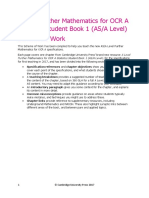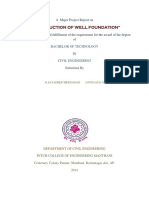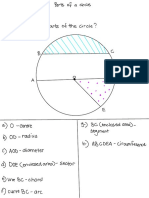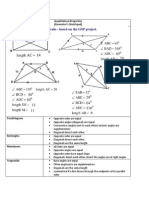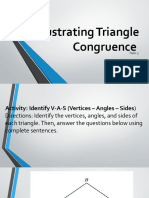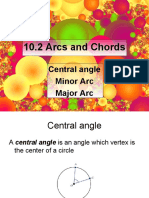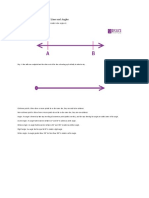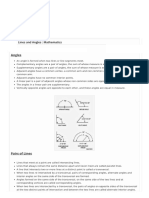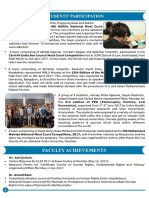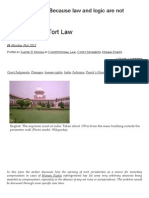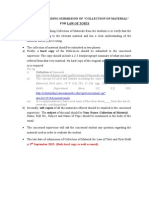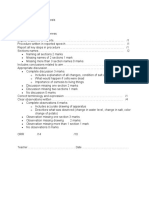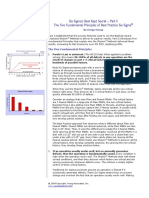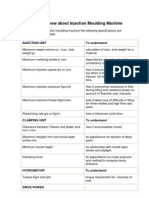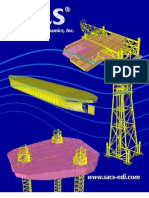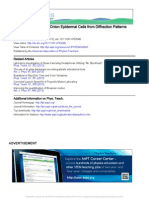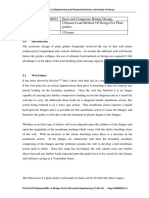Lines and Angles
Lines and Angles
Uploaded by
Sajid SheikhCopyright:
Available Formats
Lines and Angles
Lines and Angles
Uploaded by
Sajid SheikhCopyright
Available Formats
Share this document
Did you find this document useful?
Is this content inappropriate?
Copyright:
Available Formats
Lines and Angles
Lines and Angles
Uploaded by
Sajid SheikhCopyright:
Available Formats
Lines and Angles
A line is a collection of points along a straight path. A line has no endpoints. A line segment is a part of a line with two end points. a part of line with one end point is called a ray. All the points that lie on the same line are collinear points. Consider the two rays AB and AC originating from the same point A. The union of two rays AB and AC is called an angle. The rays that form the angle are called the arms of the angle. The intersection point is called the vertex of the angle. The size of an angle is measured in degrees An angle that measures less than 90 but more than 0 is called an acute angle. A right angle is an angle measuring ninety degrees, formed by the intersection of two perpendicular lines. Angles greater than 90 degrees but less than 180 degrees are known as obtuse angles. An angle that is equal to 180 degrees is called a straight angle. A reflex angle is greater than 180 degrees but less than 360 degrees. Two angles are said to be adjacent if they have a common arm and a common vertex. Linear pair of angles: Two adjacent angles are said to form a linear pair if their sum is 1800. Vertically opposite angles: When two lines intersect four angles are formed. The angles that are opposite to each other are called vertically opposite angles. Two angles are said to be complementary, if their sum is 90 degrees. Two angles are supplementary if their sum is 180 degrees. They may or may not be adjacent angles. Intersecting lines can be defined as two or more lines that meet at one point. Parallel lines can be defined as lines on the same plane that never intersect. Theorem: when two lines intersect each other, then the vertically opposite angles are equal.
Parallel Lines
Two lines having only one point in common are called intersecting lines
Two lines in the same plane are parallel if they are equidistant.
A line that intersects two or more lines, at a different points is called a Transversal
When a transversal intersects two lines, eight angles are formed, four angles at each point, P and Q respectively.
We identify these angles by their positions. 1, 2, 7 and 8 are called exterior angles 3, 4, 5 and 6 are called Interior angles 1 and 5 , 2 and 6,4 and 8 ,3 and 7 are Pair of corresponding angles 1 and 7 , 2 and 8 are pair of alternate exterior angles 4 and 6 , 3 and 5 are Pair of alternate interior angles 4 and 5 , 3 and 6 are Consecutive Interior angles on the same side of the transversal When a transversal intersects two lines Pair of corresponding angles is equal Pair of alternate exterior angles is equal. Pair of alternate interior angles is equal. Consecutive interior angles on the same side of the transversal are supplementary.
Theorem: If a transversal intersects two parallel lines, then each pair of corresponding angles are equal Theorem: If a transversal intersects two lines such that a pair of corresponding angles is equal, then the two lines are parallel to each other. Theorem: If a transversal intersects two parallel lines, then each pair of alternate interior angles is equal. Theorem: If a transversal intersects two lines such that a pair of alternate interior angles is equal, then the two lines are parallel. Theorem: If a transversal intersects two parallel lines, then each pair of interior angles on the same side of the transversal is supplementary. Theorem: If a transversal intersects two lines such that a pair of interior angles on the same side of the transversal is supplementary, then the two lines are parallel. Lines which are parallel to the same line are parallel to each other.
Theorem: The sum of three angles of a triangle is 1800.
Theorem: In a triangle if a side is produced, then the exterior angle so formed is equal to the sum of the two interior opposite angles.
You might also like
- Organic Chemistry - 0471756148 David Klein Solution ManualDocument721 pagesOrganic Chemistry - 0471756148 David Klein Solution ManualMuhammad Atif86% (7)
- SAT Number PropertiesDocument6 pagesSAT Number PropertiesΜάριος Α. ΠαππάςNo ratings yet
- A Level Further Mathematics For OCR A Statistics Student Book 1 (AS/A Level) Scheme of WorkDocument21 pagesA Level Further Mathematics For OCR A Statistics Student Book 1 (AS/A Level) Scheme of Workshah kaivanNo ratings yet
- WELL FOUNDATION Project ReportDocument53 pagesWELL FOUNDATION Project ReportRamojiNaik100% (3)
- G8 Term+3 AnglesDocument20 pagesG8 Term+3 AnglesRam AthreyapurapuNo ratings yet
- Developing An Instrument For Capturing High School Teachers' Mathematics Knowledge For Teaching: An Exploratory StudyDocument29 pagesDeveloping An Instrument For Capturing High School Teachers' Mathematics Knowledge For Teaching: An Exploratory StudyVip AmeNo ratings yet
- Geometry Unit 3 Congruence 1Document19 pagesGeometry Unit 3 Congruence 1api-287816312No ratings yet
- Postulates, Defs, and TheoremsDocument4 pagesPostulates, Defs, and TheoremsacciofabNo ratings yet
- Recurrence RelationsDocument12 pagesRecurrence RelationsSam RoxNo ratings yet
- 2016 Passback With AnswersDocument8 pages2016 Passback With AnswersHanif AhmNo ratings yet
- BPH 111 Lecture Note 2016 SessionDocument25 pagesBPH 111 Lecture Note 2016 SessionAchide Samson100% (2)
- Angara A5Document16 pagesAngara A5Junior MirandaNo ratings yet
- Geometry Postulates TheoremsDocument4 pagesGeometry Postulates TheoremsCresencio Genobiagon JrNo ratings yet
- Geometry TutorialDocument23 pagesGeometry Tutorialtakeiteasy12No ratings yet
- MODULE - Lines & AngleDocument5 pagesMODULE - Lines & AngleMadelineLimNo ratings yet
- The Triangle and Its Properties Class 7 Notes Maths Chapter 6Document7 pagesThe Triangle and Its Properties Class 7 Notes Maths Chapter 6Lakshit Dayma100% (1)
- 2lessons Circle TheoremsDocument29 pages2lessons Circle TheoremsFATMA HINDI / F MOHAMMED HUSSEIN HINDI -No ratings yet
- Circle Theorems PosterDocument1 pageCircle Theorems PosterDare JamesNo ratings yet
- 5 - Circle TheoremsDocument1 page5 - Circle TheoremsJoNsTeRsNo ratings yet
- Mathlinks 9 1 PDFDocument34 pagesMathlinks 9 1 PDFFionaNo ratings yet
- Unit VIII. 3 Perimeter and Area of PolygonsDocument13 pagesUnit VIII. 3 Perimeter and Area of Polygons100.meridithNo ratings yet
- Review For Quads TestDocument9 pagesReview For Quads TestDwi Ika YuliantiNo ratings yet
- Table 3: Plane Geometry Definitions, Theorems, Facts, Properties and TerminologyDocument4 pagesTable 3: Plane Geometry Definitions, Theorems, Facts, Properties and TerminologybjNo ratings yet
- Geometric Construction (Arcs, Circles, Polygons) PDFDocument84 pagesGeometric Construction (Arcs, Circles, Polygons) PDFAna TolentinoNo ratings yet
- Sec1 Unit6 LinesandanglesDocument30 pagesSec1 Unit6 Linesandanglesapi-350544856100% (1)
- Mathematics Through Paper FoldingDocument66 pagesMathematics Through Paper Foldingr2d2sdNo ratings yet
- Geometryfor SSC Exams (WWW - Freeupscmaterials.wordpress - Com)Document62 pagesGeometryfor SSC Exams (WWW - Freeupscmaterials.wordpress - Com)k.palraj100% (1)
- Ratio Rate Proportion and PercentDocument1 pageRatio Rate Proportion and PercentMyla Nazar Ocfemia100% (2)
- What Are We Studying Next?Document23 pagesWhat Are We Studying Next?muhammad junaid ammarNo ratings yet
- 4-7 Triangles and Coordinate ProofDocument23 pages4-7 Triangles and Coordinate ProofAbbas RazaNo ratings yet
- Circle Theorem 1-9CDocument35 pagesCircle Theorem 1-9CNatasia JonesNo ratings yet
- Quadrilateral PropertiesDocument1 pageQuadrilateral PropertiesBill LauloNo ratings yet
- Geo Sem 1.5 Measuring SegmentsDocument9 pagesGeo Sem 1.5 Measuring SegmentsJUGINo ratings yet
- Chapter 6 Unit PlanDocument13 pagesChapter 6 Unit Planapi-282333715No ratings yet
- C BX Ax: Math 154B Name - Completing The Square WorksheetDocument2 pagesC BX Ax: Math 154B Name - Completing The Square Worksheetapi-241187529No ratings yet
- The Nine-Point CircleDocument9 pagesThe Nine-Point CircleMr. Bran100% (1)
- Adjacent AnglesDocument41 pagesAdjacent AnglesAnneBecharaNo ratings yet
- Trigonometric Functions - Wikipedia, The Free EncyclopediaDocument18 pagesTrigonometric Functions - Wikipedia, The Free Encyclopediadaniyalhassan2789100% (1)
- PD.1.Introduction To AlgebraDocument45 pagesPD.1.Introduction To AlgebraRaihan Putri100% (1)
- SAT Coordinate GeometryDocument3 pagesSAT Coordinate GeometryΜάριος Α. ΠαππάςNo ratings yet
- Final Draft of Unit PlanDocument43 pagesFinal Draft of Unit PlanKarly SachsNo ratings yet
- Circle Geometry SimplifiedDocument60 pagesCircle Geometry Simplifiedcrass5469No ratings yet
- Triangle Congruence PostulateDocument12 pagesTriangle Congruence PostulateShania Deidre GamayanNo ratings yet
- Illustrating Triangle CongruenceDocument59 pagesIllustrating Triangle Congruencedimarjavillo21No ratings yet
- CH 5 Card 2Document1 pageCH 5 Card 2Mariel LognasinNo ratings yet
- Additional Mathematics Project Work 2017Document38 pagesAdditional Mathematics Project Work 2017W.y. Jee100% (3)
- Types of Triangles: by Relative Lengths of SidesDocument16 pagesTypes of Triangles: by Relative Lengths of SidesSaran Vijai100% (2)
- Geometry of The Circle PDFDocument7 pagesGeometry of The Circle PDFGregory Lewis100% (1)
- Answer Key For Circles - MAFSGeoEOCReviewCirclesGeometricMeasurenmentandGeometricProperties-AnswerKeyDocument31 pagesAnswer Key For Circles - MAFSGeoEOCReviewCirclesGeometricMeasurenmentandGeometricProperties-AnswerKeyAlexis PatelNo ratings yet
- 10 - 2 Arcs and ChordsDocument23 pages10 - 2 Arcs and ChordsReinabelle Marfil MarquezNo ratings yet
- Unit 5 Unit 5 Unit 5 Unit 5 Unit 5Document42 pagesUnit 5 Unit 5 Unit 5 Unit 5 Unit 5AjiteshPaddaNo ratings yet
- Counting Methods: Permutations CombinationsDocument31 pagesCounting Methods: Permutations CombinationsMark B. BarrogaNo ratings yet
- Surface Area of A PyramidDocument4 pagesSurface Area of A PyramidCharl Henley Q. AvilaNo ratings yet
- Misconception in MathematicsDocument40 pagesMisconception in Mathematicsippm09100% (1)
- Triangles AND Types of TrianglesDocument16 pagesTriangles AND Types of TrianglesИакс ВбдубакировNo ratings yet
- Power Point Presentation On Chapter Triangle: Mathematics FA-2 Activity-1Document6 pagesPower Point Presentation On Chapter Triangle: Mathematics FA-2 Activity-1Rishabh ManchandaNo ratings yet
- Junior Maths Challenge 2010 AnswersDocument2 pagesJunior Maths Challenge 2010 AnswersDaniel LawsonNo ratings yet
- In The West, The Shadow of The Gnomon Points East (As Shown in The Pictures Below)Document7 pagesIn The West, The Shadow of The Gnomon Points East (As Shown in The Pictures Below)ShanmugasundaramNo ratings yet
- MYP Numbers Criteria Based AssessmentsDocument3 pagesMYP Numbers Criteria Based Assessmentsdndombi22No ratings yet
- Sec 1 Math Tanjong Katong Sec SA2 2017Document19 pagesSec 1 Math Tanjong Katong Sec SA2 2017Brendan ChanNo ratings yet
- 6.6 Special QuadrilateralsDocument15 pages6.6 Special QuadrilateralsHazel Clemente CarreonNo ratings yet
- The Ultimate ECAA Guide: Economics Admissions Assessment. Latest specification with 300+ practice questions with fully worked solutions, time saving techniques, score boosting strategies, and formula sheets.From EverandThe Ultimate ECAA Guide: Economics Admissions Assessment. Latest specification with 300+ practice questions with fully worked solutions, time saving techniques, score boosting strategies, and formula sheets.No ratings yet
- Basic Terms and Definitions On Lines and AnglesDocument7 pagesBasic Terms and Definitions On Lines and Anglesprachi jainNo ratings yet
- Angles: Lines and Angles: MathematicsDocument2 pagesAngles: Lines and Angles: MathematicsJansi JayNo ratings yet
- Maharashtra National Law University Mumbai: (Established Under The Maharashtra Act VI of 2014)Document1 pageMaharashtra National Law University Mumbai: (Established Under The Maharashtra Act VI of 2014)Sajid SheikhNo ratings yet
- The Juvenile Justice (Care and Protection of Children) Act, 2015 By-Kavisha GuptaDocument9 pagesThe Juvenile Justice (Care and Protection of Children) Act, 2015 By-Kavisha GuptaSajid SheikhNo ratings yet
- OcrDocument3 pagesOcrSajid SheikhNo ratings yet
- Shift From Strict To Absolute Liability in TortsDocument6 pagesShift From Strict To Absolute Liability in TortsSajid SheikhNo ratings yet
- Distinguished Lecture SeriesDocument1 pageDistinguished Lecture SeriesSajid SheikhNo ratings yet
- Dissertation Synopsis GuidelinesDocument1 pageDissertation Synopsis GuidelinesSajid SheikhNo ratings yet
- Maharashtra National Law University Mumbai: Welcome'S All ToDocument1 pageMaharashtra National Law University Mumbai: Welcome'S All ToSajid SheikhNo ratings yet
- NUJS Brochure 2014Document67 pagesNUJS Brochure 2014Sajid SheikhNo ratings yet
- Bhim Singh MLA Vs State of J&KDocument4 pagesBhim Singh MLA Vs State of J&KSajid Sheikh100% (1)
- Constitutional Tort Law: Law or LogicDocument5 pagesConstitutional Tort Law: Law or LogicSajid SheikhNo ratings yet
- Guidelines Collection of MaterialsDocument1 pageGuidelines Collection of MaterialsSajid SheikhNo ratings yet
- Twisted Law: - It's GenesisDocument2 pagesTwisted Law: - It's GenesisSajid SheikhNo ratings yet
- 4th International Conference FinallDocument2 pages4th International Conference FinallSajid SheikhNo ratings yet
- 109 File1 CNC Report For SJP 2014 PDFDocument120 pages109 File1 CNC Report For SJP 2014 PDFSajid SheikhNo ratings yet
- 61i9-Application of Value EngineeringDocument12 pages61i9-Application of Value EngineeringIJAET JournalNo ratings yet
- Computer Associates Vs AltaiDocument14 pagesComputer Associates Vs AltaiSajid SheikhNo ratings yet
- Vote of Thanks ExamplesDocument2 pagesVote of Thanks ExamplesSajid SheikhNo ratings yet
- List of Measuring DevicesDocument8 pagesList of Measuring DevicesSajid Sheikh100% (1)
- Computer Associates Vs AltaiDocument14 pagesComputer Associates Vs AltaiSajid SheikhNo ratings yet
- Modeling of Vacuum Temperature Swing Adsorption For Direct Air Capture Using Aspen AdsorptionDocument18 pagesModeling of Vacuum Temperature Swing Adsorption For Direct Air Capture Using Aspen AdsorptionMahdi AfzaliNo ratings yet
- Design Criteria On Substation Protection by Using Instrument TransformersDocument6 pagesDesign Criteria On Substation Protection by Using Instrument Transformersbdaminda6701No ratings yet
- Questions With Answer Key: NEET-2022Document30 pagesQuestions With Answer Key: NEET-2022Aditya PatilNo ratings yet
- All Mark SchemsDocument11 pagesAll Mark SchemsSheniqua GreavesNo ratings yet
- Geophysical Characterization of Gas Hydrates: Edited by Michael Riedel Eleanor C. Willoughby Satinder ChopraDocument416 pagesGeophysical Characterization of Gas Hydrates: Edited by Michael Riedel Eleanor C. Willoughby Satinder Choprajorge luisNo ratings yet
- The 3 M Wide (Into The Page) Gate Shown in The Figure Is Hinged at Point H. Calculate The Force Required at Point A To Hold The Gate ClosedDocument2 pagesThe 3 M Wide (Into The Page) Gate Shown in The Figure Is Hinged at Point H. Calculate The Force Required at Point A To Hold The Gate ClosedKkkk PpppNo ratings yet
- Urban ClimateDocument19 pagesUrban Climateabraaolevi4009No ratings yet
- Hydraulic Engineering - Lec - 4 - StudentsDocument15 pagesHydraulic Engineering - Lec - 4 - StudentsUsman Ali0% (1)
- Strength of Material - II Lecture Note by Balemlay A.Document71 pagesStrength of Material - II Lecture Note by Balemlay A.Degsew MesafintNo ratings yet
- ShaininDocument5 pagesShainincpsinasNo ratings yet
- CP15 - 1st Sem - Syllabus - 01.07.2020Document50 pagesCP15 - 1st Sem - Syllabus - 01.07.2020SudeepNo ratings yet
- Useful Data On Plastic Injection MouldingDocument71 pagesUseful Data On Plastic Injection MouldingMahesh Deivasiga Mani D100% (2)
- Me2i and Ce2i Applied Science Question Bank 3Document14 pagesMe2i and Ce2i Applied Science Question Bank 3Umesh PatilNo ratings yet
- Microstructural and Mechanical Characterisation of 7075 Aluminium Alloy Consolidated From A Premixed Powder by Cold Compaction and Hot ExtrusionDocument10 pagesMicrostructural and Mechanical Characterisation of 7075 Aluminium Alloy Consolidated From A Premixed Powder by Cold Compaction and Hot ExtrusionsateeshNo ratings yet
- G8 Act. 345Document4 pagesG8 Act. 345Angel SuplicoNo ratings yet
- ADP MCQsDocument3 pagesADP MCQsSumra KhanNo ratings yet
- SACS BrochureDocument12 pagesSACS Brochurejakeer7100% (1)
- Paper 14Document6 pagesPaper 14Walid BecharNo ratings yet
- Solving Systems With Elimination PDFDocument5 pagesSolving Systems With Elimination PDFLoago SeropolaNo ratings yet
- Estimating The Size of Onion Epidermal Cells From Diffraction PatternsDocument5 pagesEstimating The Size of Onion Epidermal Cells From Diffraction PatternsAlexis Nathán RuedaNo ratings yet
- Drystar Axys Service Manual PDFDocument461 pagesDrystar Axys Service Manual PDFSupervisor HCV100% (4)
- ENGM032 Steel and Composite Bridge Design. Unit 5 Ultimate Load Method of Design For Plate Girders. Study Time 15 HoursDocument18 pagesENGM032 Steel and Composite Bridge Design. Unit 5 Ultimate Load Method of Design For Plate Girders. Study Time 15 Hoursmocker1987No ratings yet
- Electrmech ValveDocument12 pagesElectrmech ValvelakshmanantNo ratings yet
- Conforming and Non-Conforming ElementsDocument4 pagesConforming and Non-Conforming ElementsGourav Srusti0% (1)
- SATR-J-6602 Rev 0 PDFDocument9 pagesSATR-J-6602 Rev 0 PDFAdel KlkNo ratings yet
- 2 - Seeing Through Chaos in Multimode FibresDocument10 pages2 - Seeing Through Chaos in Multimode Fibres2540787086No ratings yet


